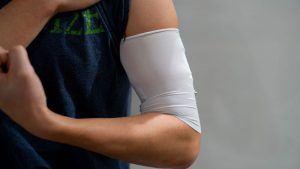
By Laura Oleniacz
North Carolina State University researchers took a step forward in the development of an armband that could track the heart’s electrical activity without requiring bulky wiring or sticky gel on the skin.
Specifically, the researchers determined the ideal placement for three electrodes in their band design, and how tightly the band needs to be worn, to best detect electrical signals from the heart.
The findings are the latest advance in a multi-institutional effort to develop an armband that takes electrocardiogram, or ECG, measurements in order to track heart rate. They are ultimately envisioning a device that could be worn as an arm sleeve throughout the day, powered by energy captured from body heat or movement.
“This study is the first step in identifying all of the components to make the armband a reality,” said the study’s first author, Braden M. Li, a Ph.D. candidate in NC State’s Wilson College of Textiles. “We identified the ideal electrode location to gather heart signals and figured out how the armband pressure affects the electrocardiogram quality.”
In the study, the researchers studied the placement of electrodes in various locations on a volunteer’s upper left arm in order to identify the best placement for three electrodes for tracking the heart’s electrical activity. They identified the best placement from among 50 different combinations. While electrodes are conventionally used “wet,” or along with a gel substance in ECG devices, researchers are working on a design that would use dry electrodes since they have the potential to be used over a longer period of time as part of a wearable device.
They also measured the pressure and heart signal of three different sizes of the band in order to understand how tightly it needs to be worn.
“If we don’t have enough compression, then we don’t get the same quality of data that we need,” said the study’s senior author Jesse S. Jur, professor of textile engineering, chemistry and science at NC State.
They made the band prototype by screen printing the electrodes into a plastic film through a method uncovered in a previous study in Jur’s lab at NC State. Then, they heat pressed the electrodes on to a polyester and spandex fabric.
“Screen printing is a very traditional process in textile manufacturing,” Li said. “We wanted to choose a manufacturing process that could be easily translated into the textile process.”
The work is part of a multi-institution research effort conducted through the National Science Foundation-funded, engineering research-based Center for Advanced Self-Powered Systems of Integrated Sensors and Technologies (ASSIST). The researchers in the center are working to develop wearable devices that can be powered by the body’s own thermal or mechanical energy. For the armband, they are working on the design to get the best heart signal while using the least amount of energy.
They are designing the armband with three electrodes, rather than with 12, so that it could potentially be powered by the wearer. While increasing the number of leads could capture the heart’s electrical signal with greater accuracy, they are working on a design that could be more easily worn, and by a person of any body type.
“Part of the goal for the ASSIST center is to design self-powered, wearable electronics,” Jur said. “We’re always balancing how much power would be required for the sensors system, data processing and communication in order to match that for the power you might be able to harvest from the body.”
The study, “Influence of Armband Form Factors on Wearable ECG Monitoring Performance,” was published online in IEEE Sensors Journal on February 18, 2021. It was authored by Li, Jur, Amanda C. Mills, and Tashana J. Flewwellin, Jacklyn Herzberg, Azin Saberi Bosari, Michael Lim and Yaoyao Jia. The study was supported by the U.S. National Science Foundation through the Engineering Research Center for Advanced Self-Powered Systems for Integrated Sensors and Technologies (ASSIST) under grant EEC 1160483.
Editor’s Note: Laura Oleniacz is Public Communications Specialist at NC State News Services.
March 19, 2021




